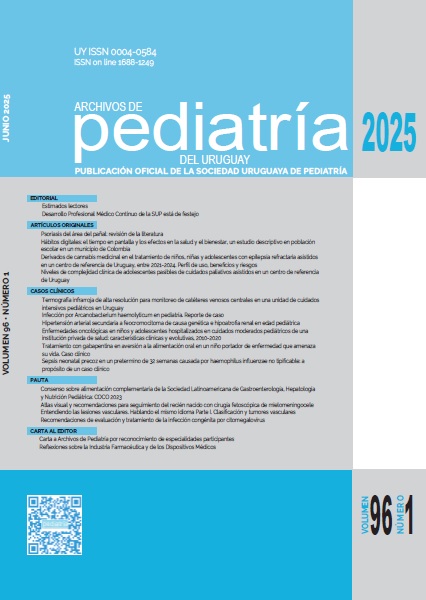Resumen
El mielomeningocele es la malformación del sistema nervioso central más frecuente que se acompaña de limitaciones funcionales y complicaciones neuro-músculo-esqueléticas, nefrourológicas e intestinales con la consecuente repercusión social y psicológica en los individuos que la presentan. La cirugía fetal con reparación del defecto es a nivel mundial y en nuestro país la primera opción de tratamiento en la actualidad. En Uruguay se han realizado más de 20 cirugías fetales con técnica SAFER. El objetivo de este atlas es guiar a los clínicos en la evaluación y el tratamiento neonatal acorde de los pacientes que fueron intervenidos en el período fetal. Se presenta una guía de abordaje multidisciplinario posnatal del recién nacido con imágenes ilustrativas y recomendaciones sobre el seguimiento neonatológico y a largo plazo neuroquirúrgico, neuropediátrico y urológico, entre otros. Destacamos la importancia de la valoración integral, individualizada y multidisciplinaria que requieren estos pacientes para optimizar los resultados quirúrgicos y funcionales.
Citas
Dendi Á, de los Santos J, Cordobez R, Silva V, Lopéz E, Piquerez C, et al. Incidencia y características de los pacientes portadores de defectos congénitos en el Servicio de Neonatología del Centro Hospitalario Pereira Rossell 2016-2020. 5 años de experiencia. Arch Pediatr Urug 2022; 93(2):e221. doi: 10.31134/ap.93.2.28.
Sanz M, Chmait R, Lapa D, Belfort M, Carreras E, Miller J, et al. Experience of 300 cases of prenatal fetoscopic open spina bifida repair: report of the International Fetoscopic Neural Tube Defect Repair Consortium. Am J Obstet Gynecol 2021; 225(6):678.e1-11. doi: 10.1016/j.ajog.2021.05.044.
Lapa D, Chmait R, Gielchinsky Y, Yamamoto M, Persico N, Santorum M, et al. Percutaneous fetoscopic spina bifida repair: effect on ambulation and need for postnatal cerebrospinal fluid diversion and bladder catheterization. Ultrasound Obstet Gynecol 2021; 58(4):582-9. doi: 10.1002/uog.23658.
Pedreira D, Zanon N, Nishikuni K, Moreira R, Acacio G, Chmait R, et al. Endoscopic surgery for the antenatal treatment of myelomeningocele: the CECAM trial. Am J Obstet Gynecol 2016; 214(1):111.e1-11. doi: 10.1016/j.ajog.2015.09.065.
Lapa D. Endoscopic fetal surgery for neural tube defects. Best Pract Res Clin Obstet Gynaecol 2019; 58:133-41. doi: 10.1016/j.bpobgyn.2019.05.001.
Adzick N, Thom E, Spong C, Brock J, Burrows P, Johnson M, et al. A randomized trial of prenatal versus postnatal repair of myelomeningocele. N Engl J Med 2011; 364(11):993-1004. doi: 10.1056/NEJMoa1014379.
Meneses V, Parenti S, Burns H, Adams R. Latex allergy guidelines for people with spina bifida. J Pediatr Rehabil Med 2020; 13(4):601-9. doi: 10.3233/PRM-200741.
Ozek M, Cinalli G, Maixner W. Spina bifida, management and outcome. Berlín: Springer, 2008.
Lapa D, Acacio G. Protocolo de cuidados neonatais com a cicatriz da cirugia fetal. São Paulo: Hospital Israelita Albert Einstein, 2023.
Yamashiro K, Galganski L, Hirose S. Fetal myelomeningocele repair. Semin Pediatr Surg 2019; 28(4):150823. doi: 10.1053/j.sempedsurg.2019.07.006.
Alruwaili A, Das J. Myelomeningocele. En: StatPearls. Treasure Island, FL: StatPearls Publishing, 2024. Disponible en: https://www.ncbi.nlm.nih.gov/books/NBK546696/. (Consulta: 8 febrero 2021).
Au K, Ashley A, Northrup H. Epidemiologic and genetic aspects of spina bifida and other neural tube defects. Dev Disabil Res Rev 2010; 16(1):6-15. doi: 10.1002/ddrr.93.
Bartonek A, Saraste H, Knutson L. Comparison of different systems to classify the neurological level of lesion in patients with myelomeningocele. Dev Med Child Neurol 1999; 41(12):796-805. doi: 10.1017/s0012162299001607.
Bowman R, Lee J, Yang J, Kim K, Wang K. Myelomeningocele: the evolution of care over the last 50 years. Childs Nerv Syst 2023; 39(10):2829-45. doi: 10.1007/s00381-023-06057-1.
Brea C, Munakomi S. Spina bifida. En: StatPearls. Treasure Island, FL: StatPearls Publishing, 2024. Disponible en: https://pubmed.ncbi.nlm.nih.gov/32644691/. (Consulta: 8 febrero 2021).
Cavalheiro S, da Costa M, Barbosa M, Dastoli P, Mendonça J, Cavalheiro D, et al. Hydrocephalus in myelomeningocele. Childs Nerv Syst 2021; 37(11):3407-15. doi: 10.1007/s00381-021-05333-2.
Copp A, Stanier P, Greene N. Neural tube defects: recent advances, unsolved questions, and controversies. Lancet Neurol 2013; 12(8):799-810. doi: 10.1016/S1474-4422(13)70110-8.
Dias L, Swaroop V, de Angeli L, Larson J, Rojas A, Karakostas T. Myelomeningocele: a new functional classification. J Child Orthop 2021; 15(1):1-5. doi: 10.1302/1863-2548.15.200248.
Du Plessis A, Johnston M. Fetal neurology. En: Arzimanoglou A, O´Hare A, Johnston M, Ouvrier R, eds. Aicardi's diseases of the nervous system in childhood. 4 ed. London: Mac Keith Press, 2018:5-84.
Geerdink N, van der T, Rotteveel J, Feuth T, Roeleveld N, Mullaart R. Essential features of Chiari II malformation in MR imaging: an interobserver reliability study--part 1. Childs Nerv Syst 2012; 28(7):977-85. doi: 10.1007/s00381-012-1761-5.
Iftikhar W, De Jesus O. Spinal Dysraphism and Myelomeningocele (Archived). En: StatPearls. Treasure Island, FL: StatPearls Publishing, 2024. Disponible en: https://pubmed.ncbi.nlm.nih.gov/32491654/. (Consulta: 8 febrero 2021).
Pico E, Wilson P, Smith K, Thomson J, Young J, Ettinger D, et al. Spina Bifida. En: Alexander M, Matthews D. Pediatric rehabilitation: principles and practice. 5 ed. New York: DemosMedical, 2015:373-411.
Tita A, Frampton J, Roehmer C, Izzo S, Houtrow A, Dicianno B. Correlation between neurologic impairment grade and ambulation status in the adult spina bifida population. Am J Phys Med Rehabil 2019; 98(12):1045-50. doi: 10.1097/PHM.0000000000001188.

Esta obra está bajo una licencia internacional Creative Commons Atribución 4.0.
Derechos de autor 2025 Archivos de Pediatría del Uruguay


